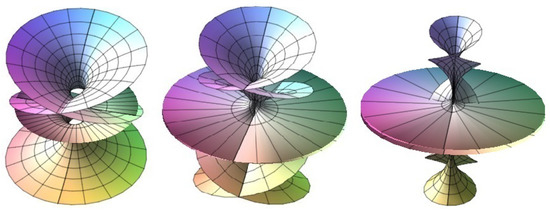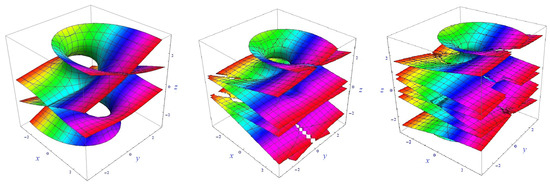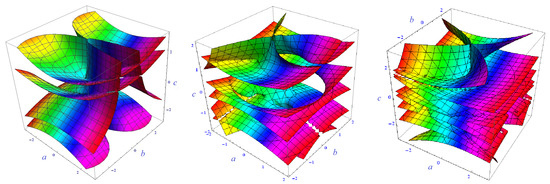Abstract
We introduce the real minimal surfaces family by using the Weierstrass data for , then compute the irreducible algebraic surfaces of the surfaces family in three-dimensional Euclidean space . In addition, we propose that family has a degree number (resp., class number) in the cartesian coordinates (resp., in the inhomogeneous tangential coordinates ).
MSC:
Primary 65D18; Secondary 53A10; 53C42
1. Introduction
A minimal surface is a kind of vanishing mean curvature surface in the three-dimensional Euclidean space . There are many classical and modern minimal surfaces in the literature. See [1,2,3,4,5,6,7,8,9] for some books, [10,11,12,13,14] for some papers related to minimal surfaces in and also [15] for those in
Lie [10] studied algebraic minimal surfaces and gave a table for these kinds of surfaces. See also [6,16,17,18,19,20,21,22,23,24] for details.
In this paper, we consider the minimal surfaces family by using the Weierstrass data for , and some integers , and then show that these kinds of surfaces are algebraic in .
In Section 2, we give the real minimal surfaces family in the and coordinates by using the Weierstrass representation in . In Section 3, we find irreducible algebraic equations by defining surfaces in terms of running the coordinates and , and we also compute degrees and classes of . Finally, we present a conclusion with all findings in Table 1 and Table 2, with a conjecture in the last section.

Table 1.
Some results of irreducible algebraic surfaces .

Table 2.
Some results of irreducible algebraic surfaces .
Here, “*” means “out of memory”. See the last section for details.
2. Type Minimal Surfaces
With the natural metric , let be a three-dimensional Euclidean space. We will refer to and from here on without further comment.
Let be an open subset of . A minimal (or lenghtless) curve is an analytic function such that where and In addition, if then is a regular minimal curve. We then have the minimal surfaces in the associated family of a minimal curve, such as that given by the following Weierstrass representation theorem for minimal surfaces (see [13] for details).
Theorem 1.
Let be a meromorphic function, and let be a holomorphic function, is analytic, defined on a simply connected open subset such that does not vanish on U except at the poles of . Then, the following
is a conformal immersion with a mean curvature identically 0 (i.e., conformal minimal surface). Conversely, any conformal minimal surface can be described in this manner.
Next, we present some findings on the Weierstrass data and the minimal curve to constuct the minimal surfaces used in the whole paper.
Definition 1.
A pair of the meromorphic function g and the holomorphic function is called the Weierstrass data for a minimal surface.
Lemma 1.
The curve
is a minimal curve, , .
We then have by using (2). Hence, in , our minimal surface is given by the following equation:
where Therefore, gives the adjoint minimal surface of the surface in (3).
Then, we get the following
Corollary 1.
The Weierstrass data
is a representation of minimal surface (3).
Taking into account the findings above with , we obtain the following minimal surfaces family
where See Figure 1 for the surfaces in the coordinates.

Figure 1.
Minimal surfaces (Left) , (Middle) , (Right) .
Hence, with the use of the binomial formula, we obtain a clearer representation of the in (3):
We study the surface in the coordinates for (we have similar results for the surface for taking at the cartesian coordinates , and also in the inhomogeneous tangential coordinates by using the Weierstrass representation equation.
Remark 1.
The surface
which has the Weierstrass data , is known as the Richmond’s minimal surface [24].
We compute the following Gauss map (see Figure 3, Left) of the surface
where
Next, we give a theorem about the minimality of surface for the integer .
Theorem 2.
The surface
is a minimal surface in .
Proof.
The coefficients of the first fundamental form of the surface (, for short) are given by the following
where That is, conformality holds. Then, the Gauss map (see Figure 3, Middle) of the surface is given by the equation below
The coefficients of the second fundamental form of are as follows
We obtain the mean curvature and the Gaussian curvature of , respectively, as follows
Hence, the surface is minimal and has a negative Gaussian curvature. □
3. Degree and Class of Minimal Surfaces
In this section, with the use of the elimination techniques, we compute the irreducible algebraic surface equations, the degrees, and the classes of the minimal surfaces family for the integers
Next, we look at some definitions on the topic.
Definition 2.
An algebraic function is a function which satisfies , where is a polynomial in , and z with integer coefficients. Briefly, an algebraic function is a function that can be defined as the root of a polynomial equation.
Definition 3.
A polynomial is said to be irreducible if it cannot be factored into nontrivial polynomials over the same field.
By eliminating u and v of we can see an irreducible algebraic equation in the cartesian coordinates. See [25] for the elimination theory.
Definition 4.
The set of roots of a polynomial gives the algebraic surface equation. An algebraic surface is said to be of degree , when
Definition 5.
At a point on a surface the tangent plane is given by the following equation
where is the Gauss map, and Then, we have the surface in the inhomogeneous tangential coordinates as follows
Finally, by eliminating u and v, we can obtain an irreducible algebraic equation of in the inhomogeneous tangential coordinates.
Definition 6.
The maximum degree of the equation gives the of
See [6] for details.
In 1901, Richmond [23] proposed the following:
Proposition 1.
There exists a real minimal surface of order 12 whose class number is 12. There are no other real minimal surfaces of order 12.
See also [11,24] for details. Next, we will obtain irreducible algebraic surfaces. Let us see our findings for the degrees and classes.
3.1. Degree
We compute the irreducible algebraic surface equation (see Figure 2, Left) of the Richmond’s minimal surface in (6) by using elimination techniques.
Then, its degree number is 12. Our findings agree with Richmond’s.

Figure 2.
Algebraic minimal surfaces (Left) , (Middle) , (Right) .
Since the real part of the third part of the integral in (1) is , then for all the following pairs x and y. We obtain the following parametric equations for the integers , respectively,
Here,
Next, we continue our computations to find for the integers We compute the irreducible algebraic surface equation (see Figure 2, Middle) of the surface in (8):
Therefore, is an algebraic minimal surface of the surface . Hence, we get the following irreducible algebraic surface equations (see Figure 2, Right for )
3.2. Class
Now, we introduce the class of the surfaces for the integers The case marked with “*” in Table 2. Before we compute the irreducible algebraic surface equations we obtain the Gauss maps (see Figure 3 for ) for the integers of the surfaces and we generalize them as follows

Figure 3.
The Gauss maps (Left) , (Middle) , (Right) .
Richmond’s minimal surface in has class 12. See [23,24] for details. Using (6), (7), (10), and (11), with we get the surface in the following inhomogeneous tangential coordinates
Therefore, we obtain the irreducible algebraic surface equation (see Figure 4, Left) of the surface :

Figure 4.
Algebraic surfaces (Left) , (Middle) , (Right) .
Hence, its class number is 12. Our findings agree with that of Richmond’s. Next, we continue our computations to find for integers To find the class of surface we use (8), (9), (10), and (11). By calculating we get the surface inhomogeneous tangential coordinates as follows
where In the inhomogeneous tangential coordinates we find the irreducible algebraic surface equation (see Figure 4, Middle) of surface as follows
Then, is an algebraic surface of . Next, we obtain the following functions where , respectively,
Corollary 2.
Considering the above odd and even integers m of the functions , for the integers , we have the following generalizations
We reveal the surfaces and . By using , respectively, and also (10), (11), we obtain the following surfaces :
Considering equations above, for odd and even numbers m, we get the following:
Corollary 3.
For the surfaces , we have the following generalizations
where the integers and
For the integers we obtain the following irreducible algebraic surface equations (see Figure 4, Right for ):
4. Conclusions
We have tried some standard techniques in the elimination theory to reveal the irreducible algebraic surface equations of the surfaces in The Sylvester method by hand works for . The projective (Macaulay) and sparse multivariate resultants were implemented on the Maple software [26] package multi-res for and .
Maple’s native implicitization command was Implicitize, and implicitization was based on Maples’ native implementation of Gröbner Basis. Later, we implemented the method in [25] (Chapter 3, p. 128) on Maple. We only succeeded for in all above methods under reasonable time.
For , the successful method we tried was to compute the equations by defining the elimination ideal using the Gröbner Basis package FGb of Faugère in [27].
The time required to output the irreducible algebraic surface equations (for integers ) and (for integers ), polynomials defining the elimination ideal, was under reasonable seconds as determined by Table 1 and Table 2.
Calculation of the class for the irreducible algebraic surface equation of marked with “*” in Table 2, was rejected (i.e., “out of memory”) by Maple 17 on a laptop Pentium Core i5-4310M 2.00 GHz, 4 GB RAM, with the time given in CPU seconds.
Finally, we give the following:
Conjecture 1.
The degree number of the irreducible algebraic surfaces, and the class number of the irreducible algebraic surfacesfor the-type real minimal surfaces are equal to the, where the integers.
Author Contributions
E.G. gave the idea for -type algebraic minimal surfaces in 3-space. Then, E.G. and Ö.K. checked and polished the draft. All authors have read and agreed to the published version of the manuscript.
Funding
This research received no external funding.
Institutional Review Board Statement
Not applicable.
Informed Consent Statement
Not applicable.
Data Availability Statement
Not applicable.
Acknowledgments
All the authors are grateful to the anonymous referees for their excellent suggestions, which greatly improved the presentation of the paper.
Conflicts of Interest
The authors declare no conflict of interest.
References
- Darboux, G. Leçons Sur la Théorie Générale des Surfaces, I, II; [Lessons on the general theory of surfaces, I, II], Reprint of the second (1914) edition (I) and the second (1915) edition (II), Les Grands Classiques Gauthier-Villars [Gauthier-Villars Great Classics], Cours de Géométrie de la Faculté des Sciences [Course on Geometry of the Faculty of Science]; Éditions Jacques Gabay: Sceaux, France, 1993. (In French) [Google Scholar]
- Darboux, G. Leçons Sur la Théorie Générale des Surfaces, III, IV; [Lessons on the general theory of surfaces, III, IV], Reprint of the 1894 original (III) and the 1896 original (IV), Les Grands Classiques Gauthier-Villars [Gauthier-Villars Great Classics], Cours de Géométrie de la Faculté des Sciences [Course on Geometry of the Faculty of Science]; Éditions Jacques Gabay: Sceaux, France, 1993. (In French) [Google Scholar]
- Dierkes, U.; Hildebrandt, S.; Sauvigny, F. Minimal Surfaces, 2nd ed.; Springer: Berlin/Heidelberg, Germany, 2010. [Google Scholar]
- Fomenko, A.T.; Tuzhilin, A.A. Elements of the Geometry and Topology of Minimal Surfaces in Three-Dimensional Space; Translated from the Russian by E.J.F. Primrose, Translations of Mathematical Monographs, 93; American Math. Soc.: Providence, RI, USA, 1991. [Google Scholar]
- Gray, A.; Salamon, S.; Abbena, E. Modern Differential Geometry of Curves and Surfaces with Mathematica, 3rd ed.; Chapman & Hall: London, UK; CRC Press: Boca Raton, FL, USA, 2006. [Google Scholar]
- Nitsche, J.C.C. Lectures on Minimal Surfaces, Introduction, Fundamentals, Geometry and Basic Boundary Value Problems; Cambridge Un. Press: Cambridge, UK, 1989; Volume 1. [Google Scholar]
- Osserman, R. A Survey of Minimal Surfaces; Van Nostrand Reinhold Co.: New York, NY, USA, 1969. [Google Scholar]
- Schwarz, H.A. Miscellen aus dem gebiete der minimalflachen. J. Die Reine Angew. Math. (Crelle’s J.) 1875, 80, 280–300. [Google Scholar]
- Spivak, M. A Comprehensive Introduction to Differential Geometry, 3rd ed.; Publish or Perish, Inc.: Houston, TX, USA, 1999; Volume IV. [Google Scholar]
- Lie, S. Beiträge zur theorie der minimalflächen. Math. Ann. 1878, 14, 331–416. [Google Scholar] [CrossRef]
- Richmond, H.W. On minimal surfaces. Trans. Camb. Philos. Soc. 1901, 18, 324–332. [Google Scholar] [CrossRef]
- Small, A.J. Minimal surfaces in R3 and algebraic curves. Differ. Geom. Appl. 1992, 2, 369–384. [Google Scholar] [CrossRef]
- Weierstrass, K. Untersuchungen über Die Flächen, Deren Mittlere Krümmung überall Gleich Null ist; Akademie der Wissenschaften zu Berlin: Berlin, Germany, 1866; pp. 612–625. [Google Scholar]
- Weierstrass, K. Über Die Analytische Darstellbarkeit Sogenannter Willkürlicher Functionen Einer Reellen Veränderlichen; Sitzungsberichte der Akademie zu Berlin: Berlin, Germany, 1885; pp. 633–639, 789–805. [Google Scholar]
- Small, A.J. Linear structures on the collections of minimal surfaces in R3 and R4. Ann. Glob. Anal. Geom. 1994, 12, 97–101. [Google Scholar] [CrossRef]
- Enneper, A. Untersuchungen über einige Punkte aus der allgemeinen Theorie der Flächen. Math. Ann. 1870, 2, 58–623. [Google Scholar] [CrossRef]
- Güler, E. The algebraic surfaces of the Enneper family of maximal surfaces in three dimensional Minkowski space. Axioms 2022, 11, 4. [Google Scholar] [CrossRef]
- Güler, E.; Kişi, Ö.; Konaxis, C. Implicit equation of the Henneberg-type minimal surface in the four dimensional Euclidean space. Mathematics 2018, 6, 279. [Google Scholar] [CrossRef]
- Güler, E.; Zambak, V. Henneberg’s algebraic surfaces in Minkowski 3-space. Commun. Fac. Sci. Univ. Ank. Ser. A1 Math. Stat. 2019, 68, 1761–1773. [Google Scholar] [CrossRef]
- Henneberg, L. Über Salche Minimalfläche, Welche eine Vorgeschriebene Ebene Curve sur Geodätishen Line Haben. Ph.D. Dissertation, Eidgenössisches Polythechikum, Zürich, Switzerland, 1875. [Google Scholar]
- Henneberg, L. Über die evoluten der ebenen algebraischen kurven. Vierteljahr. Naturforsch. Ges. Zur. 1876, 21, 71–72. [Google Scholar]
- Ribaucour, A. Etude des Elassoides ou Surfaces a Courbure Moyenne Nulle; Hayez: Bruxelles, Belgium, 1882; Volume 44, pp. 1–236. [Google Scholar]
- Richmond, H.W. Uber minimalflachen. Math. Ann. 1901, 54, 323–324. [Google Scholar] [CrossRef][Green Version]
- Richmond, H.W. On the simplest algebraic minimal curves, and the derived real minimal surfaces. Trans. Camb. Philos. Soc. 1904, 19, 69–82. [Google Scholar]
- Cox, D.; Little, J.; O’Shea, D. Ideals, Varieties, and Algorithms, An Introduction to Computational Algebraic Geometry and Commutative Algebra, 3rd ed.; Undergraduate Texts in Mathematics; Springer: New York, NY, USA, 2007. [Google Scholar]
- Maple Software, Version 17; Waterloo Maple Inc.: Waterloo, ON, Canada, 2017. Available online: https://www.maplesoft.com/ (accessed on 10 November 2021).
- Faugère, J.C. FGb: A library for computing Gröbner bases. In Proceedings of the Third International Congress Conference on Mathematical Software (ICMS’10), Kobe, Japan, 13–17 September 2010; Springer: Berlin/Heidelberg, Germany, 2010; pp. 84–87. [Google Scholar]
Publisher’s Note: MDPI stays neutral with regard to jurisdictional claims in published maps and institutional affiliations. |
© 2022 by the authors. Licensee MDPI, Basel, Switzerland. This article is an open access article distributed under the terms and conditions of the Creative Commons Attribution (CC BY) license (https://creativecommons.org/licenses/by/4.0/).